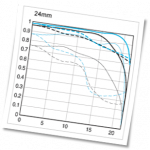Learning About Lens Quality
Today on Single-Serving Photo I’m bringing you something a little bit different. Instead of news stories about amazing photographers, press releases about equipment you can’t afford, or overbearing pontifications on the usefulness of HDR as a medium for artistic expression… Drumroll please… Graphs.
To be more specific, graphs of modulation transfer functions. Dry-sounding? Absolutely! Exciting? I sure hope so!
As the title suggests, today’s episode is concerned with lens quality. To be more precise, metrics that measure lens quality. To be yet more precise, metrics that measure sharpness, which is universally regarded to be a major factor in lens quality.
In this day and age, though it’s useful to hold equipment in your hands, to hear the sounds it makes, to feel its controls and its weight, nobody buys a professional camera or lens on the basis of a visit to the shop. That is, unless they’re quite wealthy and don’t mind making expensive errors in judgment.
No, no, this is the information age, the age of silicon and fiber optics and space travel and ray guns and… Well, not ray guns. But computers and cell phones and quartz watches and, oh yeah, that other little thing called the Internet.
That’s the Internet with a capital “I,” the one that connects computers worldwide, that connects my incoherent ramblings to you in the comfort of your own home at this very moment, and not least of all, that allows you to meticulously research every purchase you want to make, no matter how insignificant.
When it comes to researching lenses, if you’ve ever been down this road, you’ve probably come across one of my favorite sites, dpreview.com. Digital Photography Review (as it’s formally named) is probably the most technically thorough camera and lens review site in existence. They aren’t going to give you a whole lot of aesthetic or subjective fluff. Instead, they’re going to give you boat loads of data, and if you’re reading their lens reviews one of the first things you’re going to notice is the interactive lens sharpness tool.
What dpreview has done is created their own interactive tool for viewing the data points produced by many, many combined modulation transfer function graphs, which allows you to choose different focal lengths (on zoom lenses) and f-stops and observe the sharpness performance of the lens based on their measurements.
By looking at MTF measurements made by reviewers, you can determine the “sweet spot” aperture setting and focal length for a given lens and use that to produce images of a sufficient sharpness that you will be able to print them out at obscene dimensions and wave them around in front of your friends boasting about the clarity and detail you’ve been able to achieve.
After all, that’s what friends are for, right?
Now, if you want to know more about the mechanics of MTF calculations and how these measurements are taken and what they mean (which is truly interesting stuff), I highly recommend that you take a look at Camera Lens Quality: MTF, Resolution & Contrast written by Sean McHugh on the awesome Cambridge in Colour site. This is one of the more detailed explanations I’ve seen with attractive and understandable illustrations (which is the only way I can ever understand anything; you have to draw me a picture).
If you want to peruse some lens reviews and play with interactive MTF graphs, start by reading dpreview’s announcement of their new lens reviews and how their interactive tool works: Dpreview launches lens reviews.
 Single-Serving Photo
Single-Serving Photo

Comments